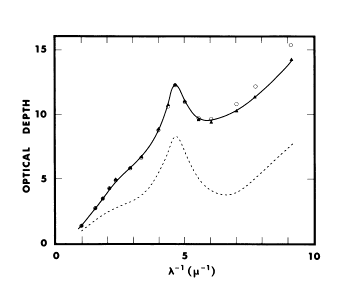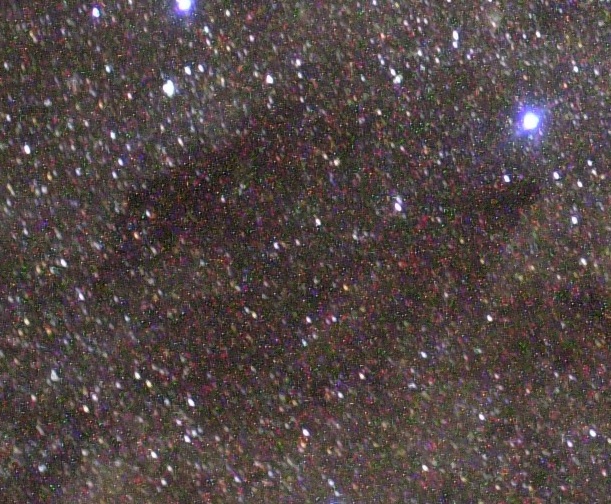In this part of the "dusty posts program" we will talk about formation and destruction of dust in the interstellar medium. Before we embark on this questions we need to know at least two things about dust: its size and composition.
As we mentioned in the last post, the dust betrays its presence by absorbing light, the absorption efficiency at some wavelength depends on the size of dust grains. Absorption is a rather complicated phenomenon because there are many physical processes that can cause absorption in our sightline, light might be literally absorbed by the dust grain or it might be scattered out of our sightline. Scattering is also dependent on the ratio between the wavelength of the scattered light and the dust grain diameter. If this ratio is small we talk of Rayleight scattering, otherwise the process is known as Mie scattering.
Detailed analysis of absorption curves leads us to believe that scattering is caused by small solid solid particles which have a diameter comparable to the wavelengths of visible light (this explains the 1/lambda behavior in the visible part of the spectrum), nonetheless we still need other components to explain some features of the absorption curve.

An average absorption curve, the far infrared is on the left and the ultraviolet on the right. There are some variations in different zones of the galaxy, but the shape of the curve is usually quite similar. We can see the peak of absorption are at 200 nm (or 1/lambda = 4.6 ).
Now let's move to the composition of dust. The Sun being so close to Earth is readily observed and we (somehow naively) assume that it is a typical star and its composition is assumed to be fairly typical of the Galaxy. We can then use the Sun abundance of elements as a guide for relative abundances between it and the interstellar medium.
We know that the relative abundances of the Sun and the interstellar medium are different. The main difference is that some elements have an underabundance of elements compared to the Sun. This elements are usually refractory, meaning that this elements can survive high temperatures without being sublimated, this directly points us to dust, as this elements can condense in dust grains that can survive in the vicinity of stars. Depletion is defined as
and as we can see below, this elements are among others Cr, Fe, Ni, Co, Ti. Despite that, the bulk of a grain is quite similar in composition to the dust you can find in your backyard and is mostly divied in to graphites, silicates and olivines.

Interstellar elemental abundances compared relative to hydrogen compared with the Sun. We can see that refractory elements are heavily depleted. The depletion is a logarithmic quantity defined, meaning that some elements like Ti are depleted by three orders of magnitude.
So, how are dust grains formed? The first idea is to think that they grow slowly in the interstellar medium. The problem with this idea is that actual calculations show that this will take too much time, suppose that at time t=0 the grain has a radius r(0), if we suppose the grain grows by addition of species i with mass m_i moving at a mean thermal speed v_i then the radius at a later time t will be
where epsilon is a "sticky coefficient" that meassures the probability that the m_i will remain attached to the grain and s is the density of the solid grain. Using the typical values for interstellar medium we find that for a typical grain (about the size of visible wavelengths) the time required is
which is too much time if we consider that the value of epsilon is smaller than one, and that the age of the universe is around 13 Gyr.
The solution comes from considering denser regions, in particular the atmospheres of cool stars. The material in stars is originally so hot that it did not contain any solids, but as it outflows in later phases of the life of the star it starts to cool with much higher densities than the interstellar medium and the atoms can arrange themselves in to the most stable molecules at that temperature (usually around 10³ K). When this outer layers are ejected in stellar winds the dust goes in to the interstellar medium. There is some controversy about the formation of dust in the early life of the universe, the most accepted view is that this dust was formed around active galactic nuclei.
Now let's move to grains destruction. The simplest way to destroy a grain is to heat it enough so it sublimates. That indeed happens in the vicinities of young, hot stars. The sublimation temperatures depend on the composition and size of the grain, this results in a stratification of the dust with large graphites closer to the star, followed by smaller graphites and large silicates, at larger distances from the star we can find smaller silicates, olivines, fused quartz and silicates with ice mantles.
A more interesting mechanism comes from accumulation of electric charges in the surface of the dust, if the grain is spherical with a radius a and is carrying a charge of Z electrons then the electrons capture cross section if the speed of the electrons is u_e is given by
When enough electric charge accumulates on the surface the stress it causes on the grain as it tries to redistribute, causes the grain to literally explode! Quite an interesting consequence for the well known fact that charges redistributes on a surface!
It actually results that the capture of species by dust grains has a crucial importance in astrobiology, keep tuned!





.jpg)






